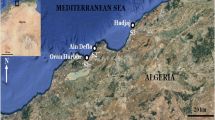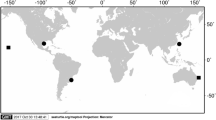Abstract
In this study, metal accumulation in green sea urchins (Strongylocentrotus droebachiensis) was investigated near the former Black Angel lead-zinc mine in Maarmorilik, West Greenland. Sea urchins (n = 9–11; 31–59 mm in diameter) were collected from three stations located at < 1 km, 5 km, and 12 km (reference site) away from the former mine site, respectively. After collection, tissue of the sea urchins was divided into gonads and remaining soft parts (viscera) before subjected to chemical analyses. Focus was on eight elements found in elevated concentrations in the mine waste (iron, copper, zinc, arsenic, silver, cadmium, mercury and lead). Sea urchins at the mine site contained significantly more copper, mercury and lead compared with the reference site for both the gonads and viscera, while the latter also contained significantly more iron, zinc and silver. Arsenic and cadmium were not significantly elevated in sea urchins at the mine site. Most elements were found in higher concentrations in the viscera compared with the gonads. For comprehensive monitoring of metal pollution at mine sites, a diverse selection of monitoring organisms is necessary. The study shows that green sea urchins accumulate selected metals and can be used as a monitoring organism for mining pollution, at least for iron, copper, zinc, silver, mercury and lead. However, the results also show that green sea urchins are less likely to reflect small environmental changes in loading of most metals (except iron, copper and silver) and for arsenic compared to suspension feeders such as blue mussels.


Similar content being viewed by others
References
Ahn, I.-Y., Jungyoun, J., & Park, H. (2009). Metal accumulation in sea urchins and their kelp diet in an Arctic Fjord (Kongsfjorden, Svalbard). Marine Pollution Bulletin, 58, 1566–1587.
Alves, M. B., Emerenciano, A. A. K., Bordon, I. C., Silva, J. R. M. C., & Fávaro, D. I. T. (2018). Biomonitoring evaluation of some toxic and trace elements in the sea urchin Lytechinus variegatus (Lamarck, 1816) in a marine environment: northern coast of São Paulo (Brazil). Journal of Radioanalytical and Nuclear Chemistry, 316, 781–790.
Aspholm, O. Ø., & Hylland, K. (1998). Metallothionein in green sea urchins (Strongylocentrotus droebachiensis) as a biomarker for metal exposure. Marine Environmental Research, 46(1-5), 537–540.
Bohn, A. (1979). Trace metals in fucoid algae and purple sea urchins near a high Arctic lead/zinc ore deposit. Marine Pollution Bulletin, 10, 325–327.
Dafni, J. (1980). Abnormal growth patterns in the sea urchin Tripneustes cf. gratilla (L.) under pollution (Echinodermata, Echinoidea). Journal of Experimental Marine Biology and Ecology, 47, 259–279.
Deheyn, D. D., Gendreau, P., Baldwin, R. J., & Latz, M. I. (2005). Evidence for enhanced bioavailability of trace elements in the marine ecosystem of Deception Island, a volcano in Antarctica. Marine Environmental Research, 60, 1–33.
Elberling, B., Asmund, G., Kunzendorf, H., & Krogstad, E. J. (2002). Geochemical trends in metal-contaminated fiord sediments near a former lead-zinc mine in West Greenland. Applied Geochemistry, 17, 493–502.
Geraci, F., Pinsino, A., Turturici, G., Savona, R., Giudice, G., & Sconzo, G. (2004). Nickel, lead, and cadmium induce differential cellular responses in sea urchin embryos by activating the synthesis of different HSP70s. Biochemical and Biophysical Research Communications, 322, 873–877.
Gopalakrishnan, S., Thilagam, H., & Raja, R. V. (2008). Comparison of heavy metal toxicity in life stages (spermiotoxicity, egg toxicity, embryotoxicity and larval toxicity) of Hydroides elegans. Chemosphere, 71, 515–528.
Hernández-Almaraz, P., Méndez-Rodriguez, L., Zenteno-Savin, T., O’Hara, T. M., Harley, J. R., & Serviere-Zaragoza, E. (2016). Concentrations of trace elements in sea urchins and macroalgae commonly present in Sargassum beds: implications for trophic transfer. Ecological Research, 31, 785–798.
Johansen, P., Asmund, G., Rigét, F., Johansen, K., Schledermann, H., (2010). Environmental monitoring at the former lead-zinc mine in Maarmorilik, Northwest Greenland, in 2009. National Environmental Research Institute, Aarhus University. 32 pp. – NERI Technical Report No. 775.
Kobayashi, N., & Okamura, H. (2004). Effects of heavy metals on sea urchin embryo development. Part 1. Tracing the cause by the effects. Chemosphere, 55, 1403–1412.
Kobayashi, N., & Okamura, H. (2005). Effects of heavy metals on sea urchin embryo development. Part 2. Interactive toxic effects of heavy metals in synthetic mine effluents. Chemosphere, 61, 1198–1203.
Larsen, T. S., Kristensen, J. A., Asmund, G., & Bjerregaard, P. (2001). Lead and zinc in sediments and biota from Maarmorilik, West Greenland: An assessment of the environmental impact of mining wastes on an Arctic fjord system. Environmental Pollution, 114, 275–283.
Lemire, M., & Himmelman, J. H. (1996). Relation of food preference to fitness for the green sea urchin Strongylocentrotus droebachiensis. Marine Biology, 127, 73–78.
Lottermoser, B.G. (2010). Mine wastes – Characterization, treatment and environmental impacts. Springer, 3 edition. 400 pp.
Rainbow, P. S. (1995). Biomonitoring of heavy metal availability in the marine environment. Marine Pollution Bulletin, 31(4-12), 183–192.
Rouane-Hacene, O., Boutiba, Z., Benaissa, M., Belhaouari, B., Francour, P., Guibbolini-Sabatier, M. E., & Faverney, C. R.-D. (2018). Seasonal assessment of biological indices, bioaccumulation, and bioavailability of heavy metals in sea urchins Paracentrotus lividus from Algerian west coast, applied to environmental monitoring. Environmental Science and Pollution Research, 25, 11238–11251.
Sadiq, M., Mian, A. A., & Saji, A. P. (1996). Metal bioaccumulation by sea urchin (Echinometra mathaei) from the Saudi coastal areas of the Arabian Gulf: 2. cadmium, copper, chromium, barium, calcium, and strontium. Bulletin of Environmental Contamination and Toxicology, 57, 964–971.
Scanu, S., Soetebier, S., Piazzolla, D., Tiralongo, F., Mancini, E., Romano, N., & Marcelli, M. (2015). Concentrations of As, Cd, Cr, Ni, and Pb in the echinoid Paracentrotus lividus on the coast of Civitavecchia, northern Tyrrhenian Sea, Italy. Regional Studies in Marine Science, 1, 7–17.
Sonne, C., Bach, L., Søndergaard, J., Riget, F., Dietz, R., Mosbech, A., Leifsson, P. S., & Gustavson, K. (2014). Evaluation of the use of common sculpin (Myoxocephalus scorpius) organ histology as bioindicator for element exposure in the fjord of the mining area Maarmorilik, West Greenland. Environmental Research, 133, 304–311.
Søndergaard, J., Asmund, G., Johansen, P., & Riget, F. (2011a). Long-term response of an arctic fiord system to lead-zinc mining and submarine disposal of mine waste (Maarmorilik, West Greenland). Marine Environmental Research, 71, 331–341.
Søndergaard, J., Johansen, P., Asmund, G., & Riget, F. (2011b). Trends of lead and zinc in resident and transplanted Flavocetraria nivalis lichens near a former lead–zinc mine in West Greenland. Science of the Total Environment, 409, 4063–4071.
Søndergaard, J. (2013). Dispersion and bioaccumulation of elements from an open-pit olivine mine in Southwest Greenland assessed using lichens, seaweeds, mussels and fish. Environmental Monitoring and Assessment, 185(8), 7025–7035.
Søndergaard, J., Bach, L., & Gustavson, K. (2014). Measuring bioavailable metals using diffusive gradients in thin films (DGT) and transplanted seaweed (Fucus vesiculosus), blue mussels (Mytilus edulis) and sea snails (Littorina saxatilis) suspended from monitoring buoys near a former lead-zinc mine in West Greenland. Marine Pollution Bulletin, 78, 102–109.
Ternengo, S., Marengo, M., El Idrissi, O., Yepka, J., Pasqualini, V., & Gobert, S. (2018). Spatial variations in trace element concentrations of the sea urchin, Paracentrotus lividus, a first reference study in the Mediterranean Sea. Marine Pollution Bulletin, 129, 293–298.
Thomassen, B. (2003). The Black Angel lead-zine mine at Maarmorilik in West Greenland. Geology and Ore, 2, 1–12.
Acknowledgements
The authors wish to thank Adrian Hehl for assistance in the field, Anna Marie Plejdrup and Thomas Hansen for their assistance in the laboratory and with the ICP-MS analysis, and Youen Grusson and Ana Maria Mingot Soriano for their assistance with sediment sieving. The Environmental Agency for Mineral Resource Activities in Greenland, the Ministry of Environment and Food of Denmark and the Arctic Research Centre, Aarhus University are acknowledged for funding. In addition, the mining company Arctic Resources (ARC) is acknowledged for providing the logistical facilities on site during the 2017 summer sampling campaign.
Funding
This project was funded by financial support from the Environmental Agency for Mineral Resource Activities in Greenland, the Ministry of Environment and Food of Denmark, and the Arctic Research Centre, Aarhus University.
Author information
Authors and Affiliations
Corresponding author
Additional information
Publisher’s note
Springer Nature remains neutral with regard to jurisdictional claims in published maps and institutional affiliations.
Rights and permissions
About this article
Cite this article
Søndergaard, J., Hansson, S.V., Mosbech, A. et al. Green sea urchins (Strongylocentrotus droebachiensis) as potential biomonitors of metal pollution near a former lead-zinc mine in West Greenland. Environ Monit Assess 191, 538 (2019). https://doi.org/10.1007/s10661-019-7637-3
Received:
Accepted:
Published:
DOI: https://doi.org/10.1007/s10661-019-7637-3




